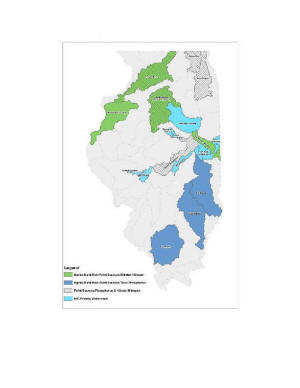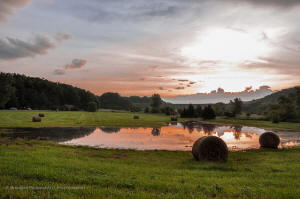|
 Farming is already packed with regulations, but last year's
passage of the Waters of the United States Rule (WOTUS) raised
greater concerns for the agriculture industry. Farming is already packed with regulations, but last year's
passage of the Waters of the United States Rule (WOTUS) raised
greater concerns for the agriculture industry.
The passage of the Rule put a new tool in the hands of the EPA that
broadens its scope of jurisdiction, virtually enabling the agency to
monitor and regulate water and contaminates that flow off of any
property and makes its way into our waterways. In the Rule's
non-specificities and broad definitions, nearly all land and any
water runoff is under regulation.
Review
1948 - Federal Water Pollution Control Act enacted to protect
waterways from pollutants.
1972 - Clean Water Act (CWA) significantly reorganized and
expanded to regulate discharges of pollutants into the waters and
regulate quality standards for surface waters.
2014 - Proposed Waters of the United States Rule (WOTUS)
published in the Federal Register Monday, April 21; 90-day public
comment period extended to October 20, 2014.

August 28, 2015 - WOTUS signed.
Oct 9, 2015 - Sixth Circuit Court of Appeals of the United
States issues a 'stay' for all of the U.S. on WOTUS Rule until it
could be examined further.
January 2016 - President vetoes opposition to WOTUS.
February 2016
- The Sixth Circuit claims jurisdiction and bundles 22
challenges to WOTUS filed by numerous states and interest
groups. Outcome pending.
- Senate vote fails to override presidential veto; WOTUS
stands.
The EPA's first order of business with the Rule in hand has
been to address silt and nutrient levels accumulating in major
watersheds. The Chesapeake Bay Watershed has become a model and
that work is well underway at this time.
In the broadest view, the Rule gives the EPA power over every
major waterway leading to a watershed.
In the narrowest context, the agency now has jurisdiction over
farms and other land-use throughout the states as every drop of
water can now be back tracked through every tributary to every
parcel of land, even taking into account dry land (fields) and
the flow of water as it runs off the surface to ditches or
through drainage tiles - that lead to a tributary - that leads
to waterways - that leads to a watershed.
It is estimated that agriculture contributes 80 percent of the
nitrogen and 48 percent of the phosphorous reaching Illinois
waterways.

Basins cover almost 75 percent of Illinois and there are there
are 18 major watersheds. Nutrients washed down the Mississippi
River end up in the Gulf of Mexico.

Agricultural sources fall into the category
nonpoint source, defined as pollution that generally results
from land runoff, precipitation, atmospheric deposition,
drainage, seepage or hydrologic modification. Nonpoint source
(NPS) pollution, unlike pollution from industrial and sewage
treatment plants, comes from many diffuse sources. As the runoff
moves, it picks up and carries away natural and human-made
pollutants, finally depositing them into lakes, rivers,
wetlands, coastal waters and ground waters.]
Representatives from agencies and non-governmental
organizations, industry, universities, agriculture, wastewater
treatment from state and federal levels, worked together to
develop the Illinois Nutrient Loss Reduction Strategy (NRLS)
with a goal aimed to reduce nitrogen and phosphorus losses by 45
percent.
Monitoring station sites have been chosen and data collected
will be used to establish baseline information, then to monitor
nutrient load limits, trends and anticipated improvements.
What this means for central Illinois farmers is that you now
need to become even more savvy in your production methods. Those
who are always conscientious about environmental impacts and
have been practicing conservation methods for years are well
ahead of the curve. For those who have not been paying
attention, you probably dread tax day too, and that day is here,
well almost.
But don't worry, you will find many resources, including your
fellow farmer that have been striving at conservation practices
and can help you get there quickly. Any direction you turn
today, you will find farm managers and crop advisors who are
current in Best Management Practices (BMP's,) 4 R's and other
strategies.
[to top of second column] |
 The good news, and there is an up side: once you sort out the
stewardship practices best suited to your operations, many of these
practices will lead to reduced fertilizer costs and cover crops that
may even provide income and other benefits for a better bottom line.
Recommendations and options for better efficacy of fertilizers,
and reduction of soil and nutrient losses in crop production:
- Get soil samples to determine specific soil needs
- Add soil amendments that make nutrients more effective
- GPS guided applications allow targeted, variable rate
applications
- Other variable rate technology that places nutrients more
where needed
- Precision application tools that place nutrients closest to
plant roots
- Split timing applies fertilizers in smaller amounts, at
times when most useful - less chance of wash away, less amount
needed, more beneficial to the plants
- Strip- or no-tillage holds soil, nutrients and moisture
- Double crop, add a winter cover crop - captures, holds and
returns nutrients to soil, particularly deep phosphorus;
improves organic matter and moisture content, may even provide a
secondary crop for livestock feed or profit
- Increase edge of field practices, buffer strips, wetlands,
bioreactors that capture and reduce nutrient loss
- Consistent record keeping
-----

It will require a combination of these actions to reach a
level of conservation that might achieve the water environmental
goals now set before the Illinois farmer.
If you haven't done it yet, today is a great day to begin
planning. If you are not there yet, there are plenty of people
around you ready to lend a hand.

Northwestern Illinois farm. Photo by Peddhapati
Resources and references:
The Fertilizer Institute 4R's - Right source rate, time, place
http://www.nutrientstewardship.
com/what-are-4rs/4r-principles
Illinois Nutrient Reduction Loss Plan
http://www.epa.illinois.gov/topics/water-quality/watershed-management/excess-nutrients/nutrient-loss-reduction-strategy/index
Illinois Stewardship Alliance
www.ilstewards.org/
Illinois Farm Bureau
www.ilfb.org/
College of Agricultural, Consumer and Environmental Sciences
http://aces.illinois.edu/
National Corn Growers Association
http://www.ncga.com
American Soybean Association
https://soygrowers.com/
Chesapeake Bay Watershed
http://www.chesapeakebay.net/
discover/baywatershed
The Final Clean Water Rule (WOTUS)
http://www2.epa.gov/sites/production/files/2015-05/documents/fact_sheet_agriculture_final.pdf

|